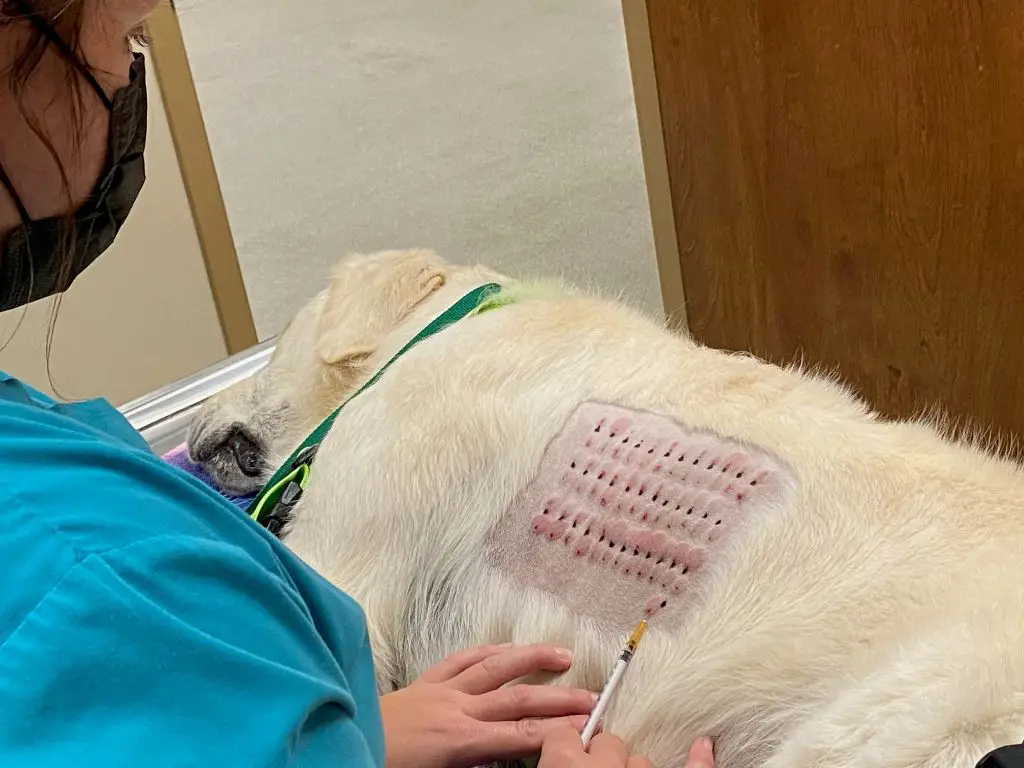Introduction to Allergy Testing for Dogs
While allergies are common among people, they also afflict our canine companions. Just like humans, dogs can suffer from environmental or food allergies that cause itchy skin, hives, gastrointestinal issues, and respiratory problems. Allergy testing is an important diagnostic tool that helps veterinarians accurately identify the specific substances triggering a dog’s allergic reactions. This allows vets to provide proper treatment and management recommendations to relieve discomfort and improve quality of life.
Allergy testing typically involves exposing a dog to known potential allergens and measuring the immune system response. Different methods check for antibodies in the blood, measure skin reactions, or analyze cellular changes. Most allergy tests require a veterinary visit, either for a skin or blood test. At-home testing kits are also available. Costs vary based on the type of testing and number of allergens tested.
This article explores the common allergy testing options for dogs, associated costs, how to interpret results, and recommended treatment plans. It provides dog owners with a helpful overview of what to expect if allergy testing is recommended for their pup.
Common Allergies in Dogs
Dogs can develop allergic reactions to a variety of substances in their environment. Some of the most common allergy triggers in dogs include:
- Food – Beef, dairy, wheat, and soy are frequent food allergen sources.
- Flea bites – Dogs can experience an allergic reaction to proteins in flea saliva.
- Environmental allergens – These include pollen, mold, dust mites, and grass.
- Contact allergens – Reactions to fabrics, plastic, rubber, wool, or other synthetic materials.
Common symptoms of dog allergies can include:

- Itchy skin, recurrent ear infections, and skin infections.
- Excessive licking, scratching, rubbing, and chewing at the skin.
- Red, scaly, irritated skin patches and hot spots.
- Hair loss and chronic skin odor.
- Frequent sneezing, runny eyes and nose.
- Vomiting, diarrhea and gas from food allergies.
When to Test for Allergies
Allergy testing for dogs is recommended when your dog shows persistent signs of allergies or skin irritation. Some common signs that may indicate allergies in dogs include:
- Excessive itching, licking, biting, or scratching at their skin or ears
- Recurrent ear infections
- Hair loss or skin lesions
- Red, inflamed skin or recurrent skin infections
- Watery eyes or nasal discharge
- Sneezing, wheezing, coughing or other respiratory issues
- Diarrhea, vomiting or other gastrointestinal issues
If your dog is displaying any of these allergy symptoms consistently over a period of weeks to months, despite your best efforts to manage them, it’s a good idea to have your vet perform allergy testing. The testing can help identify the specific allergens causing your dog distress so that more targeted treatment and management strategies can be implemented.
Allergy Testing Methods
There are two main types of allergy tests that can be performed on dogs – skin testing and blood testing. Here’s an overview of how each test works:

Skin Testing
A skin test, also known as intradermal testing, involves injecting small amounts of suspected allergens like pollen or dust mites just under the surface of the dog’s skin, usually along their side. After about 15-20 minutes, the areas are examined for any raised wheals or redness which indicates an allergic reaction. Skin testing is considered very accurate when performed properly.
Blood Testing
A blood test looks for the presence of allergen-specific antibodies in the dog’s blood. A blood sample is drawn and sent to a lab for analysis. The results typically take about 7-10 days to come back. Blood tests are less invasive than skin testing but also considered less accurate.
Comparing the Two Tests
Skin testing provides immediate results and is better for identifying specific allergens that are causing issues. However, some dogs may need to be sedated for the procedure. Blood testing is less stressful for anxious dogs since it only involves a blood draw, but it can miss mild allergies and takes longer to get results. Overall skin testing is the gold standard, but blood tests can be a good option for dogs who can’t undergo skin testing.
Cost of Allergy Testing
The cost of allergy testing for dogs can vary widely depending on the type of test performed and additional fees charged by the veterinarian. However, pet owners can expect to pay the following for common allergy tests:
Skin Testing – This test typically costs $200 to $500. Skin testing requires anesthesia and takes several hours to perform, which increases the price. Some vets may charge an additional $100 to $250 for the anesthesia and exam fees needed to perform intradermal skin testing.

Blood Testing – Expect to pay $150 to $300 for a blood allergy panel. Sending the blood sample to an external lab for analysis can raise the cost. Vet exam fees of $50 to $100 are also usually required.
Keep in mind that the prices listed above are general estimates. The exact cost of allergy testing will depend on your veterinarian, geographic location, and lab used. Your vet can provide an accurate price quote tailored to your specific dog’s needs.
Pet insurance plans may help offset the cost of allergy testing. But because allergy issues are often chronic, testing and treatment may be considered pre-existing conditions excluded by some insurance policies. Check with your provider.
Interpreting Allergy Test Results
Understanding your dog’s allergy test results can seem complicated at first. Here’s a quick guide on interpreting the results:
A positive test result indicates your dog’s immune system produced antibodies in response to that specific allergen. This means your dog is allergic to that substance. The higher the level of antibodies, the more allergic your dog is to that allergen.
A negative test result means no antibodies were detected for that allergen. This suggests your dog is not allergic to that substance. However, false negatives are possible if your dog was not exposed to the allergen during testing.
No test is 100% accurate. Your vet will look at the full panel of results rather than relying on any single positive or negative. For the most reliable diagnosis, your vet may recommend combining a blood test with an intradermal skin test to cross-check results.
It’s also important to correlate your dog’s test results with their symptoms and history. Your vet will use the test results along with your observations to guide their recommended treatment plan.
Allergy Treatment Options
Once the allergen is identified through testing, there are several ways to treat dog allergies including avoidance, medications, and immunotherapy. Avoidance involves taking steps to limit your dog’s exposure to the allergen. For environmental allergens like pollen or dust mites this may include keeping your dog indoors during peak pollen seasons, using air filters and vacuums with HEPA filters, and washing bedding frequently in hot water. For food allergies, an elimination diet or novel protein diet using a protein source your dog has not eaten before can help identify problem ingredients. Medications commonly prescribed for dog allergies include antihistamines like Benadryl to control itching and Apoquel or steroids to reduce inflammation. Long term use of steroids is not ideal, so immunotherapy or allergy shots are often recommended. Immunotherapy involves administering small amounts of the allergen to desensitize your dog’s immune system reaction over time. This treatment can lead to long term allergy relief with minimal side effects compared to medications.
Managing Dog Allergies
Once you have identified your dog’s allergies through testing, there are some things you can do at home to help manage their symptoms and keep them comfortable:
Diet – Feed your dog a hypoallergenic dog food made with novel protein sources like duck, salmon, or venison that your dog hasn’t been exposed to before. This eliminates allergens from their diet.
Medication – Your vet may prescribe antihistamines, steroids, or other medications to control itching, inflammation, and other allergy symptoms.
Bathing – Bathe your dog regularly with a gentle, fragrance-free shampoo to wash off pollen and other outdoor allergens.
Environment – Vacuum and clean your home frequently to remove dust, dander and other allergens. Consider using HEPA air filters as well.
Topicals – Your vet may recommend allergy-relieving shampoos, sprays, or supplements that can be applied topically to your dog’s skin.
It’s important to follow up with your vet and keep a close eye on your dog’s allergy symptoms. Let your vet know if the symptoms worsen or fail to improve so they can adjust treatment as needed. Consistent care is key to managing chronic dog allergies.
Allergy Prevention
While it’s difficult to completely prevent allergies in dogs, there are some steps you can take to potentially reduce allergen exposure and minimize the chances of an allergic reaction:
- Keep your home clean and dust-free. Vacuum and dust regularly, especially carpets, furniture, and pet beds. Wash dog bedding weekly in hot water.
- Limit exposure to grasses, pollens, and other environmental allergens by walking early in the morning or late evening when pollen counts are lower.
- Bathe your dog weekly or bi-weekly to remove allergens from their coat. Use a vet-recommended hypoallergenic shampoo.
- Consider an air purifier with a HEPA filter to remove allergens like dust, dander, and pollen from the air in your home.
- Feed your dog a high-quality diet with digestible protein sources to support their immune health and minimize food allergies.
- Avoid exposure to cigarette smoke, chemical cleaners, perfumes, and other irritants that can trigger allergic reactions.
- Talk to your vet about probiotics that support healthy digestion and a strong immune response.

While you can’t always prevent allergies completely, minimizing allergen exposure and supporting your dog’s immune health can reduce the likelihood of adverse reactions.
Summary
Allergy testing can help identify the triggers causing your dog discomfort, but it does come at a cost. Expect to pay $200-500 for intradermal or blood allergy testing at your vet. Skin prick and food elimination trials are cheaper alternatives around $50-150. Whatever method you choose, work closely with your vet to understand your dog’s results and develop an effective treatment plan. Controlling allergies is important to your dog’s comfort and long-term health.
While testing costs can add up, identifying your dog’s allergies is key to minimizing symptoms and reducing any long-term impacts. Work with your vet to find the most effective prevention and management options for your dog. This may include medications, immunotherapy, dietary changes, or environmental controls in your home. With some detective work and patience finding the allergy source, you can help your dog live comfortably.